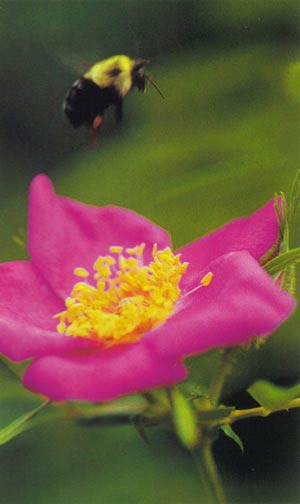It is spring again, and that means that bees are buzzing about. Recently, two studies of bees have attempted to answer two basic questions – how honeybees fly and how bumblebees learn.
How honeybees take to the air has long been an unanswered question for scientists. Honeybee flight was first studied in France in the 1930s, when scientists determined that it was theoretically impossible for the heavy, short-winged bee to fly according to known rules of aerodynamics. Since bees obviously could fly, some critics have used the fact that science has been unable to answer the question as an example of the failure of science to explain natural phenomena.
However, Michael Dickinson of the California Institute of Technology has conducted a study, published in October 2005 in the Proceedings of the National Academy of Sciences, which has finally shed new light on the matter. The French scientists in the 1930s based their calculations on the belief that a honeybee’s wings were stiff. Dickinson found instead that honeybee wings are made of a supple material, which allows the bee to flap and rotate each wing 240 times a second, creating a vortex that sucks the bee into the air.
Dickinson also found that though bees maintain a constant rate of flapping regardless of air density, they adjust the amplitude of each stroke to compensate for more difficulty creating lift at higher altitudes. In dense air near the earth’s surface, the amplitude of a bee’s wing stroke is less than 90 degrees, while in less-dense air a bee increases the arc of the stroke. Fine-tuning the amplitude also allows the bee to create more lift as it carries a heavy load of nectar or pollen.
That mystery solved, another team of scientists has discovered how the honeybee’s cousin, the bumblebee, learns which flowers are the best to dine on. At the University of Arizona, researchers set up an observation station where bees were specially trained to feast on only certain flowers. Non-trained bees were then allowed to observe the trained bees as they ate, with the trained bees being none-the-wiser. After watching, the hungry observers were released into an exact replica of the station, where they chose to dine on exactly the same types of flowers as the first group.
A second test by the researchers involved creating bee look-alikes and placing them on, or suspending them above, certain flowers. The observer bees watched this scene for a few minutes, and then the look-alikes were removed. When the observers were brought in, they chose the flower species that the faux bees favored. Previously, only birds, marine mammals and primates were thought to be able to learn by observing their neighbors, but now it seems that the social bumblebee has joined the ranks.



Discussion *